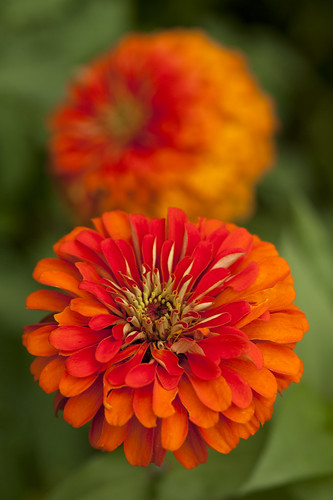Tip of the Week: Late Summer Flowers, Herbs for a Vase
Posted in Gardening Tips on September 7 2010, by Sonia Uyterhoeven
 |
Sonia Uyterhoeven is Gardener for Public Education. Join her each weekend for home gardening demonstrations on a variety of topics in the Home Gardening Center. |
 At this productive time of year, borrow some of the beauty from the garden and from nature to adorn your dinner table. Look around your garden as well as farmers markets to see what interesting flowers and herbs are available to fill a vase. Ornamental grasses and interesting foliage from woody plants will add wonderful touches to your arrangements as well.
At this productive time of year, borrow some of the beauty from the garden and from nature to adorn your dinner table. Look around your garden as well as farmers markets to see what interesting flowers and herbs are available to fill a vase. Ornamental grasses and interesting foliage from woody plants will add wonderful touches to your arrangements as well.
Recently I was at the Union Square Farmers Market perusing the vendors and admiring the kaleidoscope of cut flowers. I saw for sale bundles of sages, from culinary sage (Salvia officinalis) with its pungent, soft, fuzzy, silvery foliage to the ubiquitous mealy cup sage (Salvia farinacea ‘Victoria’). Silver is a great color to add to bouquets since it picks up light and creates drama. Gray intensifies other colors, making them glow. I love the combination of silver with red and orange. The intense blue of the Victoria sage is another good companion for autumnal colors providing wonderful contrast.
In my own garden I grow a beautiful and bountiful sage that is sometimes referred to as hummingbird, Texas, or scarlet sage, (Salvia coccinea). It also makes a nice cut flower. I often grow ‘Lady in Red’, ‘Coral Nymph’, or ‘Snow Nymph’. This ornamental sage produces an abundance of wispy spires of flowers up to the first frost.
The farmers market, not surprisingly, is full of zinnias at this time of year. The trick to keeping zinnias as well as most cut flowers fresh is to cut them constantly. I spotted the delightful Zinnia haageana. ‘Old Mexico’ and ‘Persian Carpet’ both have beautiful bicolor blooms in mahogany, gold, red, chocolate, and cream. They fill a vase beautifully on their own.
Staples in my cutting garden are large zinnias such as Zinnia elegans ‘Green Envy’ and Zinnia elegans, the Benary Giant series that come in a rainbow of colors (like the one pictured above). I find these zinnias do a decent job of keeping the powdery mildew away (eventually they all succumb) and their nice long stems make them ideal cut flowers. The one zinnia that I still haven’t grown but am dying to try is Zinnia elegans ‘Zowie!™ Yellow Flame. It’s a fiery bicolor with magenta, orange, and gold.
Give your autumn bouquets an herbal flair by adding some long stems of the purple basil ‘Red Rubin’ (Ocimum basilicum) or some of the more ornamental green-leaved varieties such as ‘African Blue’, ‘Siam Queen’, ‘Cardinal Basil’, and ‘Magical Michael’. These basils not only have a wonderful ornamental value, they also smell divine and will stimulate your olfactory senses.
Remember to cut flowers early in the morning when they are fresh and not suffering from heat stress. Take a bucket of lukewarm water into the garden and place flowers directly into the water. If you don’t have floral food at home, use a homemade solution of 1 teaspoon sugar, 1 teaspoon bleach, 2 teaspoons lemon juice.


What a wonderful idea! There is nothing quite like a beautiful bouquet of flowers and herbs.
In regards to the proposed homemade floral food, I know bleach will kill off bacteria and fungi that could reduce the longevity of your flowers but can it be replaced by something less corrosive?
Thank you!